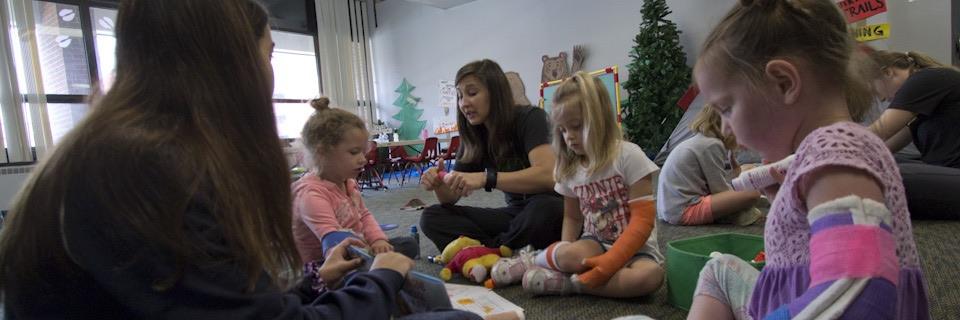Playing, With a Purpose — Short, Intensive Therapy Helmed by OT Faculty, Alumna, Yields Dramatic Results

Through the tunnel. Pick out a hat. Return to the tunnel. Repeat, this time with socks.
That was the game – and the challenge — for a group of children participating in summer therapy programs at Ability KC, an organization that provides medical, therapeutic and educational services for children and adults with disabilities.
It all sounds like fun and games — it is! — but all of these activities come with a very particular purpose. The children taking part all have one arm wrapped in a cast, part of an intensive monthlong constraint-induced movement therapy (CIMT) program held each year at Ability KC by Katie Ryan-Bloomer, Ph.D., assistant professor of occupational therapy at Rockhurst University, where she works alongside therapists including Bethany Tackett, a 2013 Master of Occupational Therapy graduate and occupational therapist at Ability KC, and current Rockhurst University OT student volunteers.
CIMT is an occupational therapy technique for those who have one-sided weakness. It involves putting the patient’s non-affected limb in a cast or other restraint for a period of time, requiring them to strengthen use of their affected limb instead. Doing that in the context of fun and games means that children are more motivated to use and develop their weaker arms.
“If it looks like play, we’re actually doing our jobs, because we’re secretly looking at lots and lots of different skills underneath,” Ryan-Bloomer said.
Each minute movement with the weaker side helps strengthen the motor skills needed to perform the kinds of everyday tasks — like tying a shoe or buttoning a shirt — that these children will perform thousands of times over the course of their lives.
Even within the world of occupational therapy, CIMT is a niche. It involves spending a lot of time with a patient over a short period, instead of short therapeutic sessions over longer periods of time. But it’s a therapeutic technique that, as Tackett and Ryan-Bloomer said, has been shown to yield big results in a short period of time.
“The changes that we get to see in the month are leaps and bounds beyond what we would typically see in someone who has a less intensive dosage,” Tackett said. “The idea of fully immersing in something that needs to and can be learned, you’re just going to achieve that skill more quickly and it will be more deeply founded.”
Ryan-Bloomer said one-sided weakness is often the result of a traumatic brain injury, a stroke before or after birth, or a tumor. But as CIMT shows, the human body has advantages even in sometimes extreme circumstances.
“We’re finding in the brain that it tends to continue to heal,” Tackett said. “We used to not understand that brain would continue to heal after an injury and now we get that.”
That same plasticity — especially in younger patients — makes CIMT-based programs such as the one at Ability KC exciting to watch, she said. But in addition to a therapy site, the summer program at Ability KC is also a chance for Ryan-Bloomer and her students to continue gathering data on CIMT for a pair of research studies based on data from two different age groups.
As a student, Tackett said she remembers helping out with the program, an experience that she said made her into a well-rounded OT, someone with an understanding of the empathy, the technique and the research best suited for individual situations. That exposure isn’t something she might have gotten at every OT program.
“I think being able to be involved with research is a unique thing that Rockhurst does really well,” she said.
Ryan-Bloomer has been studying CIMT since 2010, and running one of the programs at Ability KC since 2015. Since then, she’s seen it grow, with families now coming not only from surrounding cities in the Kansas City area but surrounding states to take advantage of the opportunity. That speaks to the progress that those enrolled in the program are able to make in a short period of time.
“I feel like the most rewarding part of this is seeing these children access their lives. I get to see their brain changing every single day and it’s amazing,” Ryan-Bloomer said. “I feel like we’re giving them access to their whole world and making life easier for them. You can’t put a price tag on it.”







